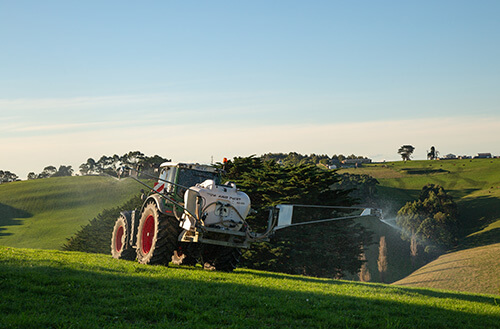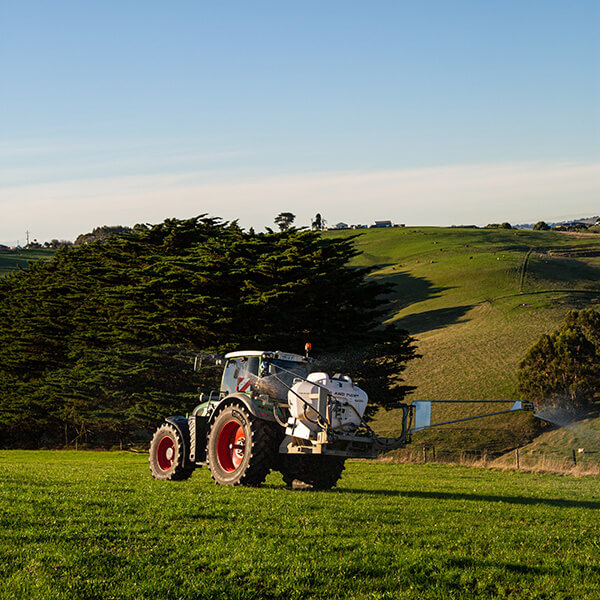REDUCING INPUTS A TOTAL GAME CHANGER
Owen Billing has reduced his ‘N’ inputs to almost zero and saved a lot of time on the farm.
Owen Billing
Dairy Farmer
Korumburra, 200 Cows, 600 Acres
Tow and Fert Multi 1200 Owner

Reducing ‘N’ inputs has been only one way Owen Billing has benefitted from a change in system.
Owen Billing has always looked to do things differently. In the early 2000’s Owen began to look at how he could change his system to a more biological and foliar based system. Up until that point Owen was like many dairy farmers relying on a solid fertilizer system to provide the nutrients his pasture needed.
Over time as Owen developed his system, he needed a machine that could handle the products he wanted to put through it. It was some time before he came across the Tow and Fert but in 2016 Owen took the leap and bought himself a Multi 1200.
On the farm now Owen says that his system has changed a lot since he first bought the Tow and Fert
“Our system has changed a lot since having the Tow and Fert. We can feed the system differently compared to when we were on a solid fertilizer program. We were pushing to much N into the system and just growing ryegrass whereas now we focus on having a high legume and herb count in the pasture.”

Above: The Tow and Fert Multi 1200

In South Gippsland, Victoria, Owen Billing sprays fertiliser on a paddock overlooking his neighbour’s properties. Owen brews his own compost tea and other biological products as well as applying small amounts of chemical-based fertilisers.
Owen Billing talks about his journey to a biological based nutrient system and how it has helped him move away from a high input model of farming.
The benefits of this system have flowed through the farm and into herd health where Owen says he has an extremely low empty rate and decreased somatic cell count.
“This is due to us using the soil properly, we are farming deeper into the ground having bigger plants with deeper root systems and the Tow and Fert enables us to stimulate growth when the time is right for the plant to grow.”
“We are growing about the same amount of pasture as before, but the quality and nutritional value of that pasture is far superior using the foliar system.”
For Owen the benefits of the Tow and Fert include being able to reduce the amount of Urea or synthetic N he is putting on,
“We have been able to reduce our synthetic N to almost nothing and we are not tied into a high input system. With the cost of Urea now, it’s a really good cost to avoid.”
To replace the N that Owen is not putting on he is putting on products that help to feed the biology in the soil. This biology then captures the free N that is available over every hectare of the farm by fixing N naturally. Owen says, “N is not our limiting factor anymore.”
The products Owen is applying to his farm are diverse. These include Fish Hydrolysate, Kelp, Humic Acids and micronized Lime, P and K products. The Tow and Fert enables all these products to be applied at once and in ratios that suit each paddocks needs saving a lot of time.
Tailored Paddock Fertility a Real Bonus
The ability to customise recipes paddock by paddock enables proactive management of growth.
Owen has now moved from a blanket approach across the farm to testing his paddock’s soil and herbage regularly which has been helping to maximise growth.
“One thing that is helpful for us is that we can tailor our fertility program to individual paddocks rather than just taking a blanket approach. We can soil test and herbage test each paddock and customize our recipe that fits that specific paddock. We can then head out to that paddock with the Tow and Fert and apply product where it is needed. So that’s a big benefit to us.”
In addition, Owen has used his Tow and Fert Multi 1200 to over-sow clover, plantain and chicory seeds which he says is a “really cost-effective way of getting more diversity into the system.”
“The Tow and Fert enables us to use products, especially home-made products and products that we couldn’t get through an ordinary boom sprayer or that we couldn’t apply any other way, things like Fish and Kelp. We can use quite viscose products and put them out without any blockages or mechanical issues.”

Applying specific brews to each paddock has allowed Owen to take control of his farm and pasture grazing, growing better quality feed for healthier animals.
Owen has been able to customise his brews for each paddock allowing for more control and better results.
Finally, Owen has reduced the farm down to once-a-day milking and has this to say about the system he is now running
“The Tow and Fert in our system has been a really crucial tool. It has enabled us to reduce our input costs considerably which has meant that we’ve been able to take the stress out of what we are doing.”
In this way, Owen says, he is no longer beholden to a lot of high cost imported products and this has made a massive difference to his family’s personal health and wellbeing and ultimately the farms as well.
“We are not worried about where the next lot of fert has to be paid from. It makes the system work holistically.”
And to farmers considering the change or wanting to do more on their farm Owen says
“I think if you are on the fence about buying a Tow and Fert then just do it, because it is a total game changer.”

Above: High in the hills of Korumburra, South Gippsland, Victoria, Australia Owen applies product to one of his paddocks.
The Tow and Fert Times.
The Tow and Fert Times is a publication full of information for dairy farmers. Designed to help you with your nutrient management and fertiliser decisions, it is packed full of helpful information, case studies and helpful tips and tricks for the farm.
Volume 9 (Autumn 2023) Available now!

